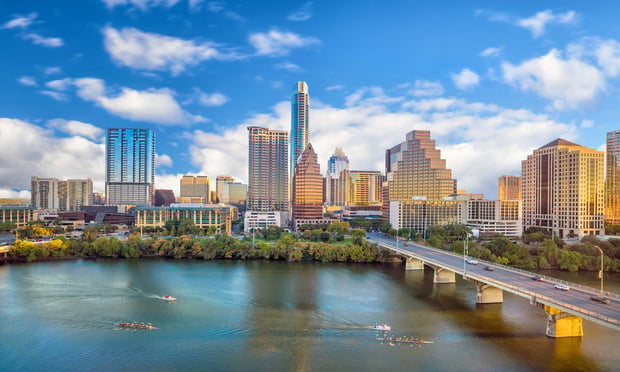 McGown says pro-business government and a high-quality workforce are driving Texas relocations.
McGown says pro-business government and a high-quality workforce are driving Texas relocations.
AUSTIN, TX/DALLAS—How much flexible space can the office market take? All signs point to significantly more, according to JLL's latest research, Markets to Watch in 2019. From up-and-coming Austin and others in between, JLL reveals the top 10 US markets poised for rapid growth of flex space in 2019.
“The world's top companies recognize there is no one-size-fits-all flexible approach, just like there's no one type of worker,” said Doug Sharp, president, JLL Corporate Solutions, Americas. “Flexible space options allow workers and teams to select the right space to perform work each day in a location that will help realize their company's mission and their own ambitions. This is one of the reasons we see so much runway for flex space in US office markets–it addresses several core needs for employers and employees alike.”
Flexible space inventory (including co-working space, incubators and other short-term space options) has grown at an annual rate of 23% since 2010. In 2018, flexible space accounted for nearly two-thirds of the country's office market occupancy gains. JLL predicts it will comprise approximately a third of the market by 2030, compared to less than 5% today.
“Pro-business governance and a high-quality workforce have long served as drivers for companies to move to Texas,” Jeremy McGown, vice president, JLL Dallas, tells GlobeSt.com. “Now, Texas is closing the gaps on the largest markets in the world as it relates to population density, entrepreneur base, tech firms and other factors that create an enticing environment for both operators and users of flex office space.”
Of the 40-plus markets evaluated in the study, Dallas ranked 12th overall, ranking among the top in individual categories including second in office net absorption since first quarter 2015 (15.3 million square feet) and seventh in population growth percentage since 2010 (15.2%).
“The Dallas office market remains one of the most active in the US, thanks to key business fundamentals and our ability to adapt and deliver what companies need, both in the immediate and the long term,” said McGown. “Established firms, those relocating and accompanying professional service firms now have more options than ever. Additionally, driven by the region's deep and diverse talent base and our historic entrepreneur spirit, these flexible work spaces are also serving as incubators for new cutting-edge start-up companies.”
So where are the top locations primed to take on flex space? JLL's research indicates across the board, every US region is expected to add more flexible offices. That said, some markets will grow faster others such as these in the top 10:
- New York–Although it's already home to the largest flex space inventory in the country with 16.1 million square feet, New York is expected to grow its lead. The city boasts the nation's highest concentration of freelancers and small businesses, which makes it the world's leading entrepreneurial economy. Access to capital is a fundamental driver of flex sector growth, as leading investors and landlords continue to create owner-operator flex space models with many of them designed for the Big Apple.
- San Francisco–Limited space options for tenants open the gate to flex: Just as it is home to technology innovation, San Francisco is an innovator in flex space. The fast-changing technology sector, combined with a historically tight office market, has created an ideal environment for co-working and incubator-style flex space offerings. With slightly more than 2.7 million square feet of flex space, the city ranks sixth among US markets, suggesting strong growth potential ahead.
- Silicon Valley–Technology consolidations and startups wire this region for flex. Despite technology industry consolidation and a wave of new offices, sustained real estate investor-fueled growth continues to translate into demand for space, including flex space. One indicator of this demand was a technology giant's approximately 450,000-square-foot lease through a flexible space operator in 2018. In addition, venture-funded startups continue to proliferate and seek short-term options to limit long-term lease liabilities.
- Austin–This is one of the standout office markets nationally, with new construction totaling more than 10% of supply and intense demand leading to double-digit rent growth both in the city center and suburbs. Comparatively low costs of living and business operations, along with a lively arts and entertainment scene, will keep attracting young residents to the city creating further demand for co-working space.
- Boston–Flex is heading to Boston to exploit its low inventory and strong fundamentals. Among gateway markets, Boston has a surprisingly slim development pipeline even as life sciences, tech and professional services users continue to consume space in new buildings. With slightly more than 2.7 million square feet of co-working space, Boston has less inventory dedicated to flex space than any other US gateway city, suggesting a strong runway ahead.
- Northern Virginia–Tech, small and veteran-owned businesses are driving flex demand. Although its flex office stock is limited, Northern Virginia is primed for flex space growth because of its large technology workforce, headquarters expansion activity in National Landing and projected increases in federal procurement spending. Government contractors are likely to boost demand for incubators and other flex space formats that bring subcontractors together.
- Washington, DC–Although the District's traditional legal services and government tenants largely avoid co-working spaces, nonprofits and political advocacy groups have been strong adopters of flex space. A growing base of technology tenants and a sizable network of freelancers have led to numerous flex space options around the Green Line micro-markets of Gallery Place, Dupont Circle, Logan, Shaw and the Ballpark.
- Seattle–The Emerald City's population and economic growth have been among the fastest of any large US city in recent years. Its rapidly growing tech sector has powered 9.2 million square feet of new office construction, with co-working operators growing to meet the demand for interim space solutions. Despite labor shortages, public policy conflicts and high housing costs, continued flex space growth is projected in Seattle.
- Denver–One of the fastest-growing metropolitan areas nationally, Denver's regional population has risen by 13.6% since 2010 to nearly 2.9 million. In its urban core, its population has grown 17.4% since 2010 and has transformed former parking lots and industrial areas into one of the most vibrant secondary markets in the country. Significant new development has included a mix of traditional office space and creative flex spaces that cater to continued demand.
- Los Angeles–The Westside continues to benefit from large-scale growth in its traditional industries such as media and entertainment, as well as digital content creation and production—industries that involve significant use of freelance creative talent and project work. Both established hubs (Santa Monica and Century City) and emerging submarkets (Playa Vista and Hollywood) are attracting a range of tenants and, in turn, flex space providers.
“Our research and our conversations with corporate executives across the globe indicate that flexible work is not just a passing trend—it's woven into the fabric of the future of work,” said Scott Homa, senior vice president and director of US office research at JLL. “Even though some markets are better positioned for rapid growth, this still leaves significant runway for expansion across all US office markets. We also expect to see continued disruption of the traditional lease model as investors, occupiers and operators come to terms with a new more flexible way of business.”
JLL's latest research is based on analysis of 25 economic, demographic and other variables in US cities. The research also includes demand projections based on current space requirements among corporate tenants and local market forecasts.
© 2025 ALM Global, LLC, All Rights Reserved. Request academic re-use from www.copyright.com. All other uses, submit a request to [email protected]. For more information visit Asset & Logo Licensing.





